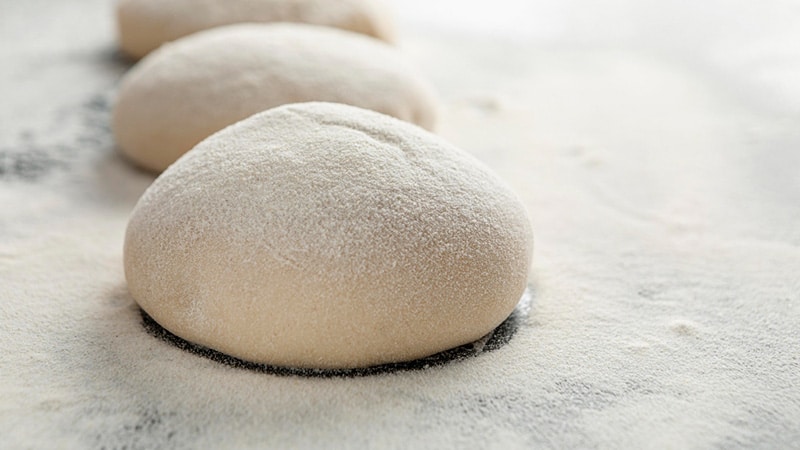Sometimes leftover dough can sit in the fridge for too long, or you may have forgotten to check the expiration date on the store-bought dough.
Whatever the case may be, it’s important to know how to tell if pizza dough is bad.
In this article, we’ll explore the signs of bad pizza dough, including its smell, taste, texture, and color.
The Smell
One of the most obvious signs that pizza dough has gone bad is its smell.
If the dough smells sour or has a funky odor, it’s likely that it has started to ferment and is no longer safe to use.
The smell may also be reminiscent of vinegar or alcohol.
If you notice any of these odors, it’s best to discard the dough and start fresh.
Here are some additional details about the smell of pizza dough that can indicate whether it has gone bad:
Yeasty Odor
Fresh pizza dough has a pleasant, yeasty smell due to the presence of live yeast cells.
As the yeast consumes the sugars in the dough, it produces carbon dioxide and other by-products that give the dough its characteristic aroma.
However, if the dough has been left to ferment for too long, the yeast cells can die off and release a foul, unpleasant odor.
Moldy Odor
If the pizza dough has been contaminated with mold, it will emit a musty, moldy odor.
Mold can grow on the surface of the dough or inside it, especially if it has been stored in a damp or humid environment.
If you notice any signs of mold on the dough or smell a moldy odor, it’s best to discard it immediately.

Rancid Odor
If the pizza dough has gone bad due to exposure to air or high temperatures, it may develop a rancid odor.
This smell can be described as oily, greasy, or even metallic, and it indicates that the dough has started to spoil.
Rancidity can also be caused by the presence of rancid fats or oils in the dough, which can give it an off-flavor.
Sour Odor
If the pizza dough smells sour or acidic, it may have started to ferment.
Fermentation occurs when the yeast and bacteria in the dough consume the sugars and produce lactic acid and other organic acids.
While a mild sourness is normal in pizza dough, an overpowering sour odor can indicate that the dough has gone bad and should be discarded.
Alcoholic Odor
If the pizza dough smells like alcohol or has a strong, pungent odor, it may have started to ferment to the point of producing alcohol.
This can happen if the dough has been left to rise for too long or if it has been stored in warm temperatures.
A strong alcohol odor can indicate that the dough has gone bad and should not be used.
In summary, the smell of pizza dough can provide valuable clues as to its freshness and safety.
By paying attention to the yeasty, moldy, rancid, sour, or alcoholic odors that may emanate from the dough, you can determine whether it’s safe to use or whether it has gone bad and should be discarded.
Remember that pizza dough is a perishable food item, and it’s important to store it properly and use it within a reasonable amount of time to avoid spoilage.
The Taste
Of the various ways to determine if pizza dough has gone bad, taste is perhaps the most definitive.
A bad taste in the dough can be an indicator of spoilage, contamination, or over-fermentation.
Here are some details about how the taste of pizza dough can help you decide if it’s safe to use:

Sour Taste
One of the most common signs of spoiled pizza dough is a sour taste.
This is often caused by the fermentation of sugars in the dough by yeast and bacteria.
While some mild sourness is normal in pizza dough, an overpowering sour taste can indicate that the dough has started to spoil.
The sourness can be described as acidic or vinegary, and it may be accompanied by a pungent or funky flavor.
Metallic Taste
If the pizza dough has a metallic taste, it may be due to the presence of rancid oils or fats.
This can happen if the dough has been stored for too long or at too high of a temperature, causing the oils to oxidize and become rancid.
A metallic taste can also be a sign of contamination with metals or other toxins, which can be harmful to consume.
Bitter Taste
A bitter taste in pizza dough can indicate that it has been over-kneaded or over-risen.
This can cause the gluten proteins to break down and release bitter compounds, resulting in a less-than-desirable flavor.
A bitter taste can also be a sign of contamination with mold or other microorganisms, which can produce toxic or bitter compounds.
Moldy Taste
If the pizza dough has been contaminated with mold, it will have a musty, moldy taste.
Mold can grow on the surface of the dough or inside it, especially if it has been stored in a damp or humid environment.
Moldy dough should not be consumed, as it can cause food poisoning or other health issues.
Off-Flavor
If the pizza dough has an off-flavor or strange taste that you can’t quite identify, it may be a sign of spoilage or contamination.
An off-flavor can be described as anything that doesn’t taste like normal pizza dough, such as a chemical taste, a burned flavor, or a medicinal taste.
In summary, the taste of pizza dough can provide important clues as to its safety and freshness.
A sour, metallic, bitter, moldy, or off-taste can be a sign of spoilage, contamination, or over-fermentation.
If you detect any of these flavors in your pizza dough, it’s best to err on the side of caution and discard it.
Remember to store pizza dough properly, use it within a reasonable amount of time, and inspect it carefully before use to ensure its safety and quality.
The Texture
Texture is another important aspect of pizza dough that can help you determine if it has gone bad.
The texture of pizza dough can provide clues about its freshness, contamination, and fermentation.
Here are some details about how to use texture to assess the quality of pizza dough:
Sticky Texture
If the pizza dough feels sticky or has a tacky texture, it may be a sign of over-proofing or over-fermentation.
When dough ferments for too long, it becomes sticky and difficult to handle.
The excess moisture can also make the dough dense and heavy, resulting in a less-than-ideal crust.
Tough Texture
If the pizza dough feels tough or hard to the touch, it may be due to over-kneading or under-proofing.
Kneading dough too much can result in tough gluten strands that resist stretching and shaping.
Under-proofed dough may not have had enough time to develop the gluten structure, resulting in a dense and chewy texture.
Slimy Texture
A slimy or slick texture in pizza dough can be a sign of contamination with bacteria or mold.
These microorganisms can produce a slimy film on the surface of the dough or inside it, making it unpleasant to handle and difficult to shape.
Slimy dough should not be used, as it can cause food poisoning or other health issues.
Dry Texture
If the pizza dough feels dry or crumbly, it may have been stored for too long or at too low of a humidity level.
This can cause the dough to lose moisture, making it difficult to shape and resulting in a dry and brittle crust.
Inconsistent Texture
Inconsistent texture in pizza dough can be a sign of poor mixing or uneven proofing.
If the dough has large air pockets or dense spots, it may be due to uneven distribution of ingredients or inconsistent rising.
This can result in a lumpy or uneven crust that doesn’t cook evenly.
In summary, the texture of pizza dough can provide important clues about its quality and safety.
Sticky, tough, slimy, dry, or inconsistent textures can be a sign of over-proofing, contamination, or poor handling.
If you notice any of these textures in your pizza dough, it’s best to discard it and start fresh.
Remember to store pizza dough properly, use it within a reasonable amount of time, and handle it carefully to ensure its texture and quality.
The Color
The color of pizza dough can also give you important information about its freshness and safety.
Here are some details about how to use color to assess the quality of pizza dough:
White or Beige Color
Fresh pizza dough is typically white or light beige in color.
This color is due to the presence of wheat flour, water, and yeast in the dough.
If the dough is still within its shelf life and has been stored properly, it should maintain this color until it’s ready to be used.
Grayish or Yellowish Color
If the pizza dough has started to spoil or ferment, it may take on a grayish or yellowish hue.
This is a sign that the dough has been exposed to air and has started to oxidize, or that it has been fermenting for too long.
While a mild discoloration may not affect the safety or flavor of the dough, a significant color change can indicate spoilage and should be discarded.
Green or Blue Spots
If you notice green or blue spots on your pizza dough, it’s a sign of mold growth.
Mold can develop on the surface of the dough or inside it, especially if it has been stored in a damp or humid environment.
Moldy dough should not be consumed, as it can cause food poisoning or other health issues.
Dark Brown or Black Spots
Dark brown or black spots on pizza dough can indicate that it has been burned or scorched.
This can happen if the dough is left in the oven for too long or if it comes into contact with a hot surface.
While a few small spots may not affect the safety or flavor of the dough, a significant amount of burning can make the dough unappetizing and should be discarded.
Red or Pink Color
If the pizza dough has a reddish or pinkish hue, it may be a sign of contamination with bacteria or other microorganisms.
This can happen if the dough has been stored at too high of a temperature or if it has come into contact with contaminated surfaces or ingredients.
Red or pink dough should not be used, as it can cause food poisoning or other health issues.
In summary, the color of pizza dough can provide important information about its safety and freshness.
While some discoloration may be normal, significant changes in color or the presence of mold, burning, or contamination can indicate spoilage and should be discarded.
Remember to store pizza dough properly, use it within a reasonable amount of time, and inspect it carefully before use to ensure its safety and quality.
Preventing Pizza Dough from Going Bad
To prevent pizza dough from going bad, it’s important to store it properly.
If you’re using store-bought dough, make sure to check the expiration date before purchasing it.
Once you’ve opened the package, store it in an airtight container or tightly sealed plastic bag in the refrigerator.
Homemade pizza dough should also be stored in an airtight container or bag in the refrigerator.
It’s also important to use the dough within a reasonable amount of time.
Store-bought dough typically has a shelf life of a few days to a week, while homemade dough should be used within three to four days.
Freezing the dough can also help extend its shelf life, but make sure to thaw it in the refrigerator before using it.
Final Word
In conclusion, knowing how to tell if pizza dough is bad is essential for creating a safe and delicious pizza.
By paying attention to the dough’s smell, taste, texture, and color, you can ensure that your pizza dough is fresh and safe to use.
By storing your dough properly and using it within a reasonable amount of time, you can prevent spoilage and enjoy great pizza every time.
